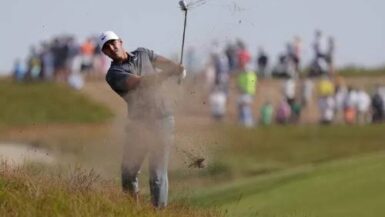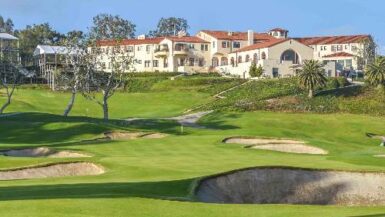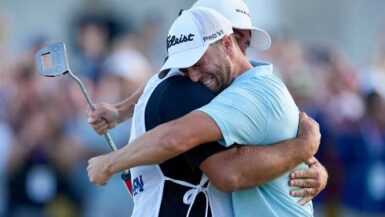California – a prophet on the burning shore
California – knockin’ on the Golden Door
Like an angel, standing in a shaft of light
Rising up to paradise, I know I’m gonna shine…
— Bob Weir and John Barlow
LA JOLLA, CA – The sky was golf ball white, sending caddies and spotters scrambling over the fabled kikuyu of Torrey Pines’s South Course to see where balls might have landed. Patrons in shirtsleeves shivered, drank dreadfully bitter, watery coffee, and huddled near the clubhouse, venturing on to the course in small groups only. Players were in long sleeves from leaden-slate sunrise to granite-grey sunset on Tuesday. In the typical “June Gloom” as it’s known locally, it was a day more akin to February at the Buick rather than the U.S. Open in high summer, but even so the watch-light of desire burns boldly in the hearts of every player in the field. You don’t need sunshine to get geared up for a U.S. Open. With a newer, more player-friendly set-up, player anticipation is at an all-time high.
“It’s what every player dreams about, becoming a major champion” Padraig Harrington explained in his typical candid, matter-of-fact delivery when describing the amplified drive and excitement of a major championship. “The U.S. Open brings an increased element of expectation, puts a bit more stress in a week like this” he explained. “There’s no question you probably try a little bit harder.”
Having won last year’s Open Championship at stern, stoic Carnoustie -reputedly the toughest major championship venue in the World – Harrington can afford an understatement or two. But beneath the sincere demeanor burns the same unquenchable fire that drives every professional golfer. “Having won a major as a player, you want to go on and win two” he finished. Harrington is not the only one chomping at the bit to get started; the locker room, practice green, and players’ lounges were all agog with the same news: this course can be had. After decades of chip-out rough, terrifyingly narrow fairways, and triple-bogeys lurking at every corner, the U.S. Open had become kinder and gentler.
This year the U.S. Open is completely different from decades of Opens that came before; it’s being contested on an ordinary tour stop, a course the boys see every February and know like the back of their hand – a few stragglers aside. Maybe a European Tour star here or an amateur there are unfamiliar, but the hum and zing and cricketing from the players room is almost unanimous, the course is playing fairly easy for a U.S. Open venue – Toto I don’t think we’re in Mamaroneck anymore.
Indeed, Harrington sounded quite optimistic. “From what I’ve heard, everybody is pleased with the course, which may be a little disappointing. It’s always nice when about half the field gives up….I would fancy the chances of some of the short, straight hitters…it looks wide open in terms of the field, plenty of opportunities for everybody to play well.”
That sure is different for Tuesday copy at our Open. For decades, the tournament was known as “The Tricked Up Open” – singularly defined as the hardest week in professional golf because of parquet floors for greens, Amazonian rain forests for rough, and green Christmas ribbons masquerading as fairways. But since Mike Davis inherited tournament set-up duties from the controversial Tom Meeks, fresh ideas have brought more players into the mix. Rough has been graded to punish a bad shot according to how far off line it traveled, rather than just being an automatic wedge out, whether you missed by one yard or thirty. Players can get into a flow or rhythm instead of chopping and around, running hot because they can’t consistently hit fairways and greens. The adjustments from the Torrey of the Buick Open and the Torrey of the 2008 U.S. Open are minimal.
“I’m gonna have to play a little shorter and a little smarter than at the Buick” explained Bubba Watson. “The balls bounce a little more on the greens and the course is longer and the rough a little different. For example, on 14 I normally hit driver, but I’ll try 4-wood or 3-iron.” With such minimal adjustments as these, Watson has to like his chances. “If I just stay in the moment and play smart, I’ll be okay. I’ll just try to keep playing it easy and not get too excited about the extra pressure of a major.”
Boo Weekley echoed his sentiments. “I’m just gonna go out and play. I reckon it’s just a golf course, drive it, hit it agin’, putt it…good things can happen.” The course isn’t saying “Boo!” to Boo. When asked about comparing the the two Torreys of 2008, he responded, “they is pretty similar. The greens are faster and not as bumpy, but the speed will make up for them not being like Oakmont. Those greens were scarier than a dog bite!” He smiled and shook his head as if to add “Hoo Whee!” before continuing. “I’m just gonna find my fall line and trust it.” When Boo Weekley feels good about his chances, you know things have changed at the U.S. Open.
‘The course looks lovely, but also looks to be a fair test” said Sweden’s Fredrik Jacobsen, another of Europe’s hopes to break the winless drought that has plagued them since Tony Jacklin won at Minnesota’s Hazeltine National in 1970. (It took British Open style rain and wind for eliminate most of the field, as Jacklin cruised to a seven-shot victory).
“If I hit my driver straight, I can play for the middle of the green and get some good looks at birdie” Jacobsen continued. “And on the par-5s, I have no problem with laying up and getting chances to score with my wedges.
Indeed, the flattish greens – considerably easier than Pinehurst, Oakmont, or Winged Foot – allow players to be as aggressive as an ordinary tour stop if they find the fairway and that means more players will be thinking they can be in the mix – and maybe it’s their best chance to seize a major and the life-changing rewards that come with achieving that lifelong dream. “I’m not changing my game plan from the Buick much at all” agreed Rod Pampling. The course plays similar and I’m comfortable with the shots. I’ll worry about the excitement I feel about this week if I’m in the mix come Sunday.”
2005 U.S. Open Champion Michael Campbell concurred. “It’s much more generous than Oakmont. The greens are not as severe and the fairways are wider than normally at the Open.”
There are some other differences as well – nothing too eye-popping, just little things to be careful about. “We’re playing different distances in the tee boxes than what we normally do for the Buick” Tiger Woods noted. “So getting a feel for that over the practice rounds is pretty important to developing a feel, but also developing a game plan.” On some holes, tee boxes will differ from day to day. “On 13 we’re almost on Black’s Beach” Woods joked. Moreover, the rough can be uneven in placed. “That’s the tricky part” Tiger remarked with raised eyebrows and a nod, as if confirming that the person asking the question knew an important secret. “We can get lies in that first cut that sit up where literally you can hit driver, like Bubba Watson did, in a practice round, where normally it’s an automatic wedge.”
Yet, in some places, a similar drive may get punished. “We like the fact that these lies in the first fairway cut will be inconsistent” said the U.S.G.A.’s Jim Hyler. “The last two years at Winged Foot and Oakmont, the first primary cut of the rough was too thick, the density was too thick, and it required the players to generally just chop out” he began. “But here you’ll see all kinds of lies in the rough, from chop outs to having absolute perfect lies. I think somebody mentioned in their remarks that Bubba Watson hit a driver, had a lie that was so perfect in the first primary cut on the 9th hole that he actually hit a driver out of there. You can see the inconsistencies that are going to occur in the rough.”
Woods also noted that the greens will putt differently. The lines are much higher now. I’m used to seeing lines a little straighter, a little bit lower and with a lot less pace. Some of the putts have a lot more swing at the end. They’re rolling out a bit more.”
Nevertheless, in Tuesday’s practice rounds, Woods hit similar shots to those he hit during the Buick. “I played the course exactly the same way as Buick except on 14 it was 3-wood, not 5-wood off the tee.” That’s bad news for the field. With Woods winning six Buicks, (four consecutive) and a World Junior, he is a prohibitive favorite. You know the drill over the four days, it’s like a Dr. Seuss story – One Round, Two Rounds, Three Rounds, Four: Tiger’s in the mix, Tiger’s in the lead, Tiger pulls away, Tiger takes a victory lap, Dan Hicks swoons over him like a freshman fumbling at a gorgeous sorority girl’s skirt.
British poet Percy Bysshe Shelley once wrote a line that used to describe the U.S. Open to a tee: “will not with equalizing blow, abase the high, exalt the low, and in one mighty shock o’erthrow.” Our Open used to be a minefield of unexploded double bogeys. But now we’re kicking back in laid-back California, The Golden State, and in competing for the silver encrusted U.S. Open Championship Trophy, players are reaching for the brass ring, knocking on the golden door, thoughts of a warm future stirring in every breast. With a set-up this ordinary, this genial, this subdued, more people believe they have a chance. Now it’s T.S. Eliot’s poetry that comes to mind instead, “Only those who risk going too far can possibly find how far one can go.” Carpe diem, gentleman, you may never get a better chance.




